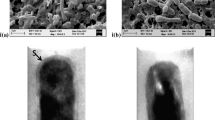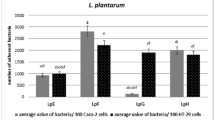Abstract
A quantitative approach has been proposed to evaluate the competitive inhibition of Escherichia coli and Salmonella typhi by live and heat-inactivated laboratory isolated Lactobacillus sp. on adhesion to monolayer of Caco-2 cells. Three species of Lactobacillus (L. casei, L. acidophilus, L. agilis) isolated from human neonate feces and two commercial probiotic strains (L. casei, L. acidophilus) have been compared for probiotic activity. All lactobacilli were able to attach to the Caco-2 cells, however, the degree of adhesion was bacterial strain-dependent. The adhesion indices of the two commercial probiotic strains were not significantly different from the values obtained for the other two similar fecal strains (p > 0.01). The inhibition of attachment of the pathogenic bacteria by inactivated cells of fecal L. acidophilus was examined and compared to the results of live bacteria. The inhibition pattern was similar for live and heat-inactivated L. acidophilus (p > 0.01). The number of attached pathogenic bacteria to the Caco-2 cells decreased when the number of L. acidophilus increased from 106 to 109 CFU/mL. The heat-inactivated L. acidophilus displayed similar probiotic activity compared to the live bacteria.
Similar content being viewed by others
Abbreviations
- CFU:
-
colony forming unit
- MRS broth:
-
Man-Rogosa-Sharp broth
- SCDB:
-
soybean-casein digest broth
- EMB agar:
-
eosin-methylene blue agar
- PBS:
-
phosphate-buffered saline
- SS agar:
-
Salmonella-Shigella agar
References
Baron E.J., Finegold S.M.:Bailey & Scott’s Diagnostic Microbiology, 8th ed., pp. 323–332. C.V. Mosby Co., St. Louis (USA) 1990.
Benno Y., Mitsuoka T.: Impact of Bifidobacterium longum on human fecal microflora. Microbiol.Immun. 36, 683–694 (1992).
Čepeljnik T., Lah B., Narat M., Marinšek-Logar R.: Adaptation of adhesion test using Caco-2 cells of anaerobic bacterium Pseudobutyrivibrio xylanivorans, a probiotic candidate. Folia Microbiol. 52, 367–373 (2007).
Coconnier M.H., Bernet M.F., Chauviere G., Servin A.L.: Adhering heat-killed human Lactobacillus acidophilus, strain LB, inhibits the process of pathogenicity of diarrheagenic bacteria in cultured human intestinal cells. J.Diarrh.Dis.Res. 11, 235–242 (1993).
Drago L., Gismondo M.R., Lombardi A., de Haén C., Gozzini L.: Inhibition of in-vitro growth of enteropathogens by new Lactobacillus isolates of human intestinal origin. FEMS Microbiol.Lett. 153, 455–463 (1997).
Ebringer L., Ferenčík M., Krajčovič J.: Beneficial health effects of milk and fermented dairy products — review. Folia Microbiol. 53, 378–394 (2008).
Elliot S.E., Buret A., Mcknight W., Miller M.J.S., Wallace J.L.: Bacteria rapidly colonize and modulate healing of gastric ulcers in rats. Am.J.Physiol. 275, G425–G432 (1998).
FAO/WHO: Health and Nutritional Properties of Probiotics in Food Including Powder Milk with Live Lactic Acid Bacteria. Report of a joint FAO/WHO expert consultation on evaluation of health and nutritional properties of probiotics in food including powder milk with live lactic acid bacteria, Cordoba (Argentina) 2001.
Fazeli M.R., Shahverdi A.R., Sedaghat B., Jamalifar H., Samadi N.: Sourdough-isolated Lactobacillus fermentum as a potent anti-mould preservative of a traditional Iranian bread. Eur.Food Res.Technol.218, 554–556 (2004).
Fazeli M.R., Toliyat T., Samadi N., Hajjaran S., Jamalifar H.: Viability of Lactobacillus acidophilus in various vaginal tablet formulations. Daru14, 172–178 (2006).
Fuller R.: Probiotics in man and animals. J.Appl.Bacteriol. 66, 365–378 (1989).
Juven B.J., Schved F., Linder P.: Antagonistic compounds produced by a chicken intestinal strain of Lactobacillus acidophilus. J.Food Prot.55, 157–161 (1992).
Kato I., Endo K., Yokokura T.: Effects of oral administration of Lactobacillus casei on antitumor responses induced by tumor resection in mice. Internat.J.Immunol.16, 29–36 (1994).
Klaenhammer T.R.: Probiotic bacteria: today and tomorrow. J.Nutr.130, 415S–416S (2000).
Koninkx J.F.J.G., Malago J.J.: The protective potency of probiotic bacteria and their microbial products against enteric infections — review. Folia Microbiol.53, 189–194 (2008).
Krieg R.N., Holt J.G.: Bergey’s Manual of Systematic Bacteriology, Vol. 2., pp. 1208–1234. Williams and Wilkins, Baltimore 1984.
Lee Y.K., Salminen S.: The coming of age of probiotics. Trends Food Sci.Technol.6, 241–244 (1995).
Lidbeck A., Gustafasson J.A., Nord C.: Impact of Lactobacillus acidophilus supplements on the human oropharyngeal and intestinal microflora. Scand.J.Infect.Dis.19, 531–537 (1987).
Ouwehand A.C., Salminen S.J.: The health effects of cultured milk products with viable and non-viable bacteria. Internat.Dairy J.8, 749–758 (1998).
Perdigon G., Alvarez S., Gobbato N., de Budeguer M.V., de Ruiz Holgado A.A.P.: Comparative effect of the adjuvant capacity of Lactobacillus casei and lipopolysaccharide on the intestinal secretary antibody response and resistance to Salmonella infection in mice. Food Agric.Immunol.7, 283–294 (1995).
Rigon-Zimmer K., Mullié C., Tir-Touil-Meddah A., Buisson P., Léké L., Canarelli J.P.: Impact of colostomy on intestinal microflora and bacterial translocation in young rats fed with heat-killed Lactobacillus acidophilus strain LB. Folia Microbiol.53, 89–93 (2008).
Salminen S., Ouwehand A., Benno Y., Lee Y.K.: Probiotics: how should they be defined?. Food Sci.Technol.10, 107–110 (1999).
Saxelin M., Pessi T., Salminen S.: Fecal recovery following oral administration of Lactobacillus strain GG (ATCC 53103) in gelatin capsules to healthy volunteers. Internat.J.Food Microbiol.25, 199–203 (1995).
Schiffrin E.J., Brassart D., Servin A.L., Rochat F., Donnet-Hughes A.: Immune modulation of blood leukocytes in humans by lactic acid bacteria: criteria for strain selection. Am.J.Clin.Nutr.66, 515S–520S (1997).
Servin A.L.: Antagonistic activities of lactobacilli and bifidobacteria against microbial pathogens. FEMS Microbiol.Rev.28, 405–440 (2004).
Tamura N., Norimoto M., Yoshida K., Hirayama C., Nakai R.: Alteration of fecal bacterial flora following oral administration of bifidobacterial preparation. Gasteroenterol.Japan18, 17–24 (1983).
Walencka E., Różalska S., Sadowska B., Różalska B.: The influence of Lactobacillus acidophilus-derived surfactants on staphylococcal adhesion and biofilm formation. Folia Microbiol.53, 861–866 (2008).
Author information
Authors and Affiliations
Corresponding author
Rights and permissions
About this article
Cite this article
Ostad, S.N., Salarian, A.A., Ghahramani, M.H. et al. Live and heat-inactivated lactobacilli from feces inhibit Salmonella typhi and Escherichia coli adherence to caco-2 cells. Folia Microbiol 54, 157–160 (2009). https://doi.org/10.1007/s12223-009-0024-7
Received:
Revised:
Published:
Issue Date:
DOI: https://doi.org/10.1007/s12223-009-0024-7




